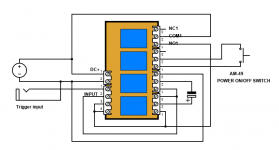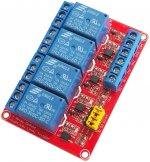Hello diyaudio community!
New to the forum, was wondering if maybe you could help me out or point me to the right direction.
I have an old akai am-49 stereo amplifier that I absolutely love and in a couple of months I will be moving to a new place where my audio setup would require a power amp.
Now i would hate to just decommission the akai since it was my dad's ... So I was wondering if there would be a way to use a 12 trigger in modification and maybe bypass the volume?
I have the service manual with schematics and everything if anyone is interested.
Thanks a lot!
New to the forum, was wondering if maybe you could help me out or point me to the right direction.
I have an old akai am-49 stereo amplifier that I absolutely love and in a couple of months I will be moving to a new place where my audio setup would require a power amp.
Now i would hate to just decommission the akai since it was my dad's ... So I was wondering if there would be a way to use a 12 trigger in modification and maybe bypass the volume?
I have the service manual with schematics and everything if anyone is interested.
Thanks a lot!
Sure you can do that. The positive is that the AM-49 has a standby power supply with a relay to turn on the power amplifier, so it would be possible to add a 12V trigger with a small interface circuit of a couple of resistors and maybe a diode, connected to the base of TR156.
Unfortunately the unit does not have pre-out / line-in connections, so you have a couple of options. You could use the line input and just leave the amplifier volume at 12 o'clock, and all tone controls etc bypassed. Or you could add the missing line in connections for the power amplifier, which doesn't require any active circuitry, just some connectors. W108 from the volume control board goes the 'out' connectors and P108 on the power amplifier board comes from the 'in' connectors instead (remove the loom between the two W & P connectors). To use as a power amplifier alone, connect to the new 'in' connectors. If you want to use the internal preamp, just plug some jumper leads from the new 'out' to the new 'in'.
If you didn't want to drill the back panel and add connectors, then you could repurpose, say, tape 3 connectors to become pre-out / line-in. Obviously you'd lose the ability to have three tape units connected.
Unfortunately the unit does not have pre-out / line-in connections, so you have a couple of options. You could use the line input and just leave the amplifier volume at 12 o'clock, and all tone controls etc bypassed. Or you could add the missing line in connections for the power amplifier, which doesn't require any active circuitry, just some connectors. W108 from the volume control board goes the 'out' connectors and P108 on the power amplifier board comes from the 'in' connectors instead (remove the loom between the two W & P connectors). To use as a power amplifier alone, connect to the new 'in' connectors. If you want to use the internal preamp, just plug some jumper leads from the new 'out' to the new 'in'.
If you didn't want to drill the back panel and add connectors, then you could repurpose, say, tape 3 connectors to become pre-out / line-in. Obviously you'd lose the ability to have three tape units connected.
Last edited:
hey johnmath!
thank you so very much for you detailed and well put response. now myself i haven't probed deep into amp electronics and circuits, but i will do some reading based on your instructions and worst case scenario will print out this thread and take my amp to a technician! if you have any suggestions regarding the parts you mentioned or a general guide to this modification i would deeply appreciate it! thanks again!
thank you so very much for you detailed and well put response. now myself i haven't probed deep into amp electronics and circuits, but i will do some reading based on your instructions and worst case scenario will print out this thread and take my amp to a technician! if you have any suggestions regarding the parts you mentioned or a general guide to this modification i would deeply appreciate it! thanks again!
would this board work as a 12v trigger to connect on TR156?
Dual Hi-Lo Switched Relay Board | Quasar Electronics AS3156KT
paired with something like this for a 3.5mm jack input
https://images-eu.ssl-images-amazon.com/images/I/412wlU+CjdL.jpg
Dual Hi-Lo Switched Relay Board | Quasar Electronics AS3156KT
paired with something like this for a 3.5mm jack input
https://images-eu.ssl-images-amazon.com/images/I/412wlU+CjdL.jpg
You can probably do something simpler.
I think you should be able to turn on the amplifier by injecting 5 volts into the base of TR156 on the main amplifier board. This transistor’s base is connected via R178 to pin 26 of the microprocessor on the tone board, which is the source of the normal power on/off signal.
To derive 5 volts from your 12 volt trigger source you can use a potential divider. I think a 12 volt trigger circuit can usually supply 100mA, but TR156 doesn't need much current. I suggest the potential divider be chosen for about a 5mA draw from the 12volt trigger source; less will be tapped off for the transistor.
From the 12 volt trigger source to ground connect two resistors, one end of a 15kΩ from positive, the other end of the 15kΩ to a 10kΩ and then the other end of that to ground. The centre connection of these two resistors will be:
12v x (10k ÷ (10k + 15k)) = 4.8 volts.
This is enough to turn on TR156 and the amplifier.
To seperate the microprocessor from the new trigger source you are adding, add a diode and a 10kΩ resistor between the 4.8 volt point of your potential divider and the base of TR156, and also add a diode in series the R718 from the microprocessor so that your new trigger voltage does not feed back to the microprocessor or visa versa.
Try this at your own risk and only attempt if you are comfortable working around mains powered circuitry.
Hopefully if I have made an error someone else will chip in with a correction.
I think you should be able to turn on the amplifier by injecting 5 volts into the base of TR156 on the main amplifier board. This transistor’s base is connected via R178 to pin 26 of the microprocessor on the tone board, which is the source of the normal power on/off signal.
To derive 5 volts from your 12 volt trigger source you can use a potential divider. I think a 12 volt trigger circuit can usually supply 100mA, but TR156 doesn't need much current. I suggest the potential divider be chosen for about a 5mA draw from the 12volt trigger source; less will be tapped off for the transistor.
From the 12 volt trigger source to ground connect two resistors, one end of a 15kΩ from positive, the other end of the 15kΩ to a 10kΩ and then the other end of that to ground. The centre connection of these two resistors will be:
12v x (10k ÷ (10k + 15k)) = 4.8 volts.
This is enough to turn on TR156 and the amplifier.
To seperate the microprocessor from the new trigger source you are adding, add a diode and a 10kΩ resistor between the 4.8 volt point of your potential divider and the base of TR156, and also add a diode in series the R718 from the microprocessor so that your new trigger voltage does not feed back to the microprocessor or visa versa.
Try this at your own risk and only attempt if you are comfortable working around mains powered circuitry.
Hopefully if I have made an error someone else will chip in with a correction.
I would be aiming to maintain galvanic isolation between trigger and amplifier circuitry if at all possible, so would rather advise using the 12 V trigger to drive an optocoupler first; an additional transistor may be needed for logic inversion.
How about use a relay NO contacts across AM-49 power on/off switch, send a momentary pulse to turn on the amplifier when a 12V trigger is presented, another momentary pulse to switch it off when the 12V trigger signal is stopped.
I built a remote interface using a 4channel relay module and a capacitor to control an older Classe power amplifier which required momentary pulses to turn on/off, I believe it should works on AM-49 as well.
I built a remote interface using a 4channel relay module and a capacitor to control an older Classe power amplifier which required momentary pulses to turn on/off, I believe it should works on AM-49 as well.
Attachments
- Home
- Amplifiers
- Power Supplies
- Turning an old stereo amp into a power amp with 12v trigger

